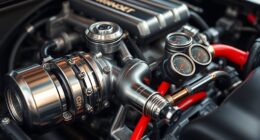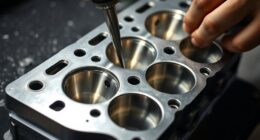To choose the right suspension upgrades, first assess your driving needs—whether you want better handling, comfort, or off-road capability—and confirm compatibility with your vehicle. Consider different options like coilovers, sway bars, or air suspensions based on your goals and budget. Think about installation complexity and long-term reliability, and seek support from reputable brands. If you keep exploring, you’ll discover how to make the best choices for your vehicle’s performance and safety.
Key Takeaways
- Assess your driving conditions, vehicle load, and handling goals to select compatible suspension upgrades.
- Choose the appropriate suspension type—coilovers, sway bars, or air suspension—based on your performance needs.
- Set a budget and prioritize quality and durability to ensure long-term reliability and value.
- Verify compatibility with your vehicle model and consider professional installation for complex components.
- Match upgrades to your vehicle usage—daily driving, off-road, or performance racing—for optimal results.
Understanding Your Driving Needs and Goals

Before choosing suspension upgrades, understanding your driving needs and goals is vital. Think about where and how you drive most often. If you mostly hit rough, pothole-filled roads, you’ll want a suspension that absorbs impacts better. A suspension designed for rough terrain can significantly improve ride comfort and durability. Urban driving calls for comfort-focused upgrades to smooth out bumps and reduce fatigue. If you face harsh weather like snow or heavy rain, specialized components can help maintain control. Consider your vehicle’s load capacity—heavier loads demand stiffer, more durable suspensions. Also, evaluate your tires’ condition, since worn tires affect suspension performance. Clarifying whether you want sharper cornering, improved straight-line stability, or better braking will guide you in selecting the right upgrades. Additionally, understanding vehicle suspension systems can help you choose the most suitable modifications for your specific needs. By aligning your goals with your driving conditions, you’ll make smarter choices that enhance safety, comfort, and vehicle performance.
Exploring Different Types of Suspension Upgrades

Understanding your driving goals helps narrow down the best suspension upgrades for your vehicle. Different upgrades serve unique purposes, so knowing what you want—whether improved handling, comfort, or load capacity—is key.
Coilovers are versatile, offering adjustable ride height and damping, making them ideal for performance and daily driving and are often used in custom builds to achieve specific handling characteristics. They often include adjustable components that allow customization to suit different driving conditions. Additionally, coilovers can improve your vehicle’s stability during aggressive driving, providing better control and safety.
Sway bars reduce body lean and enhance stability during sharp turns, perfect for sporty driving.
Air suspensions provide height adjustment and a smoother ride, especially useful for varying loads or off-road use, though they’re more complex and costly. Multi-link suspensions excel in grip and control, suitable for high-performance vehicles, but are intricate and expensive to maintain.
Meanwhile, Macpherson and Double Wishbone setups balance cost and stability, with Double Wishbone delivering better handling.
Each type caters to different driving needs and preferences.
Assessing Your Budget and Cost Implications

Assessing your budget and understanding the cost implications of suspension upgrades are crucial steps in making informed decisions. Start by setting a clear budget to prevent overspending.
Remember, labor costs range from $150 to $300, which should be added to parts expenses. Consider additional costs like wheel alignments or repairs that may arise during installation. Consulting manufacturer specifications can help determine the appropriate parts for your vehicle.
Labor costs for suspension upgrades typically range from $150 to $300, plus additional expenses for alignments and repairs.
DIY installation can cut costs markedly, but only if you have the skills and tools. Research deals, discounts, or used parts from reputable brands like Monroe or KYB to stay within your financial limits.
Suspension component costs vary—shock absorbers typically cost $450 to $1,200 including labor. Higher-end parts or complex systems increase expenses.
Choosing high-quality parts can enhance the longevity and performance of your suspension upgrade, making the investment worthwhile.
Balancing quality and affordability ensures you get good value without exceeding your budget. Proper assessment of existing components and project goals is essential to avoid unnecessary expenditures and focus on upgrades that deliver the best performance for your investment.
Considering Compatibility With Your Vehicle

Ensuring suspension components are compatible with your vehicle is essential for safe and effective upgrades. You need to confirm that parts are designed or certified for your specific make and model to guarantee proper fitment and function. Cross-check manufacturer specifications and OEM part numbers to prevent incompatibility and potential damage. Shocks and struts are critical parts of the suspension system, and using incompatible components can lead to poor handling and accelerated wear. Be aware that some aftermarket parts may require additional modifications or adapters. Keep in mind that legal regulations might restrict certain modifications, especially those affecting vehicle height or handling. Compatibility also impacts your warranty; using non-approved parts can void it. When considering suspension type, match factory or aftermarket options carefully, ensuring they align with your vehicle’s design. Additionally, understanding the hybrid bicycle versatility can help determine if certain suspension upgrades are suitable for different terrains, ensuring optimal performance and comfort. Proper compatibility guarantees safe performance, longevity, and maintains your vehicle’s integrity during upgrades. Recognizing the importance of narcissistic traits can help you identify potential issues in the selection process and avoid unnecessary complications.
Evaluating Installation Complexity and Support

When upgrading your vehicle’s suspension, evaluating the complexity of installation and the support available is essential to avoid costly mistakes or safety issues. Components like coilovers require precise adjustments and specialized tools, often needing professional installation to guarantee proper alignment and handling. Proper installation can prevent issues such as uneven tire wear or compromised safety features. Adjustable shocks demand ongoing tuning, and incorrect settings can compromise stability. Anti-roll bars and bushings may need modifications or labor-intensive work, such as bushing removal or corrosion management. Manufacturer support varies: detailed instructions, technical assistance, and warranty coverage are key for a smooth process. Post-installation, alignment and damping calibration are mandatory, and documentation helps maintain safety. To mitigate risks, verify components beforehand, use proper tools, and consult community forums for common pitfalls. This collaborative approach can provide valuable insights and support resources for your upgrade process. This ensures your upgrade is safe and effective. Additionally, understanding the installation complexity involved can help you determine whether to undertake the upgrade yourself or seek professional help.
Making an Informed Decision for Optimal Performance

Making an informed decision about suspension upgrades begins with clearly defining your performance goals. Whether you want better handling and control, increased speed and agility, or improved ride comfort, your objectives will guide your choices. Air suspension, for example, offers adjustable ride height and superior comfort, making it ideal for versatile driving conditions. Assess which components—like shocks, sway bars, or coilovers—best suit your needs, considering factors like adjustability and spring rates. Think about your vehicle’s primary use: daily driving, racing, off-road, or heavy loads. Budget plays a role too; options range from affordable lowering springs to high-end coilovers. Research reputable brands, read community feedback, and verify compatibility with your car. Additionally, considering the long-term reliability of your suspension components can save costs and ensure consistent performance over time. Finally, consider warranty and support to ensure long-term reliability. Making these informed choices ensures your suspension upgrades deliver the performance and driving experience you desire.
Frequently Asked Questions
How Do Suspension Upgrades Affect Overall Vehicle Safety?
Suspension upgrades considerably boost your vehicle’s safety by improving handling, stability, and braking performance. They reduce body roll, enhance traction, and help manage weight distribution, which shortens stopping distances.
Upgraded suspensions also minimize the risk of skidding and loss of control, especially on slippery roads or during emergency maneuvers. By maintaining proper suspension, you guarantee better control, reduce accident risks, and increase overall safety for you and your passengers.
Can Suspension Upgrades Improve Fuel Efficiency?
Suspension upgrades can improve your fuel efficiency by reducing road resistance, maintaining tire grip, and enhancing weight distribution.
When you choose high-performance shock absorbers, you enhance vibration damping and vehicle stability, which helps you drive more smoothly and efficiently.
Proper maintenance, like keeping tire pressure essential, also plays an important role.
While some upgrades may slightly decrease fuel economy, selecting the right components can make your ride more economical overall.
What Maintenance Is Required After Installing Suspension Upgrades?
After installing suspension upgrades, you need to regularly inspect your components, checking for leaks, damage, and wear.
Keep tires properly aligned and inflated, and monitor bushings and control arms for signs of deterioration.
It’s vital to get your suspension aligned after upgrades and to check camber and toe settings.
Clean and protect components from dirt and rust, and schedule periodic inspections to guarantee everything functions smoothly and safely.
Are There Legal Restrictions on Certain Suspension Modifications?
You should know that legal restrictions on suspension modifications vary by state and federal regulations. In some places like California, there are strict height limits, emissions standards, and safety requirements.
Other states may have fewer rules, but safety still matters. You need to guarantee your upgrades comply with local laws to avoid fines, citations, or vehicle impoundment.
Always check your state’s regulations before making any suspension changes to stay street-legal.
How Long Do Suspension Upgrade Components Typically Last?
Your suspension upgrade components are like fine wine—they age differently based on use and care. Typically, shocks and struts last 50,000–100,000 miles.
Control arms and ball joints can go up to 150,000 miles if maintained well. Springs often outlast other parts but weaken after 100,000 miles.
Rough roads, heavy loads, and poor maintenance can shorten their lifespan, so regular inspections are key.
Conclusion
Choosing the right suspension upgrade can transform your driving experience, but did you know that 70% of drivers who upgrade report better handling and ride comfort? By understanding your needs, exploring options, and considering your budget, you’ll make an informed choice that boosts performance and safety. Remember, investing in the right suspension isn’t just about upgrades — it’s about enjoying every mile with confidence and control. Make your upgrade count and hit the road smarter today.









